List of Lord Vishnu Dashavatar in order (correct information and explanation) | What are the 10 avatar of Lord Vishnu? | Why are the ten avatars of Vishnu important? | Which is the first avatar of Vishnu (with proof)
Namaste friends, how are you doing today? Welcome to #BhagavanBhakthi website / blog.
Bhagavan Lord Sri Vishnu (Krishna) (Rama) blessings to you and your family!
In this website / blog, you will always learn about #Hinduism #Sanskrit language.
Also subscribe to my YouTube channel from this link #BhagavanBhakthi to view videos about #Hinduism #Sanskrit language.
Just before going to “List of Lord Vishnu Dashavatar in order (correct information and explanation) | What are the 10 avatar of Lord Vishnu? | Why are the ten avatars of Vishnu important? | Which is the first avatar of Vishnu (with proof)“, let us have some brief information.
![]()
Meaning of avatar (Hinduism) : An avatar is an incarnation, that is, a God (Vishnu) adopts a human (or any kind of) form to be manifested on earth as per his own will, wish, time, situation, etc. without anybody’s interference, support or help.
In Sanskrit avatar is written as अवतार (avatāra).
Why do Vishnu take avatar (on earth) : The main purpose is to destroy evil on earth and to establish righteousness. Also to spread the correct knowledge among the sajjanas (good people) about the Hinduism (Sanatana Dharma).
Vishnu as preserver : Lord Sri Vishnu is regarded as the preserver of the unlimited universes (multiverse) and along with his avatar all the other Devatas (Demigods) take avatar (incarnation) on this earth to serve Lord Sri Vishnu.
Lord Sri Vishnu has already has taken nine such avatars (incarnations) and the tenth and final incarnation is due in the future at the end of Kali Yuga as Lord Sri Kalki.
Why are the ten avatars of Vishnu important? : This is because Lord Sri Vishnu shows different types of ‘leelas’ (pastimes / teachings) in different avatars to teach Dharma to all.
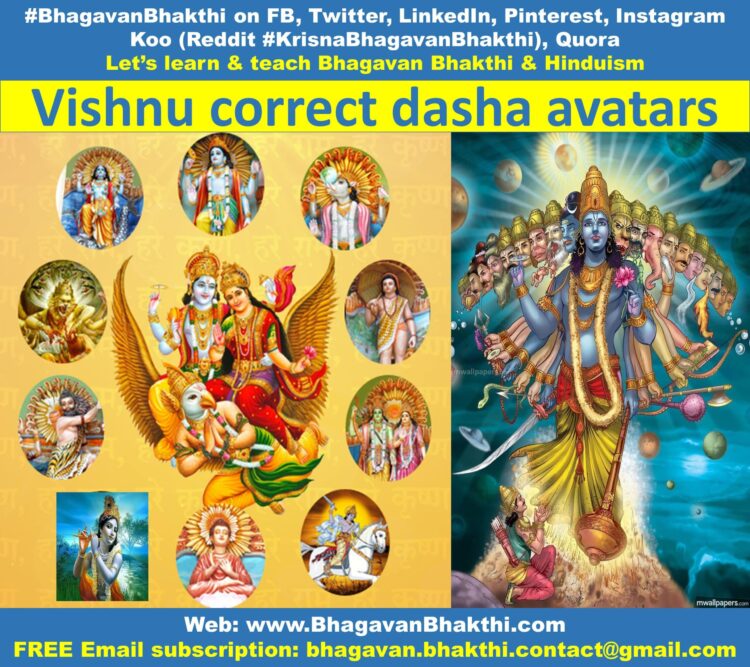
Just before proceeding further, I would like to add a very important point.
The correct order of Lord Sri Vishnu avatar as per Srimad Bhagavatam is as given below:
1. Varaha | 2. Narasimha Swamy | 3. Matsya | 4. Kurma | 5. Vamana | 6. Parashurama | 7. Rama | 8. Krishna | 9. Buddha | 10. Kalki |
Many say it is Matsya avatar, Kurma, Varaha, Narasimha, Vamana, Parashurama, Rama, Krishna, Buddha and Kalki is the correct order.
But, as per Srimad Bhagavatam (Bhagavata Purana) the avatar as mentioned above with numbers is correct., that is, starting from Varaha avatar (let’s find answer for this below).
Which is the first avatar of Vishnu (with proof) : Bali Chakravarti (Mahabali) was present during the Kurma avatar. He was heading all the demons for the Amrit Manthan (churning of ocean) (Samudra Manthana).
Whereas his grand father Prahlada was present in Narasimha Swamy avatar itself.
If Kurma avatar has taken place before Narasimha avatar, how come Bali Chakravarti (Mahabali) was present during the Kurma avatar, before the birth of his grand father Prahlada Maharaja.
This proof is more than enough to tell that Varaha avatar was the first avatar and not Matsya avatar.
List of Lord Vishnu Dashavatar in order (correct information and explanation) is as given below:
1. Varaha (Boar incarnation) : To save mother earth (Goddess Sri Bhudevi) from the clutches of the demon Hiranyaksha.
2. Narasimha (Half Lion and half human incarnation) : An incarnation in the form of a being who was half-man and half-lion to slay down the demon Hiranyakashipu (Hiranyakashyap).
3. Matsya (Fish incarnation) : To save all the living beings on earth due to heavy rains. King Manu, saptarishis (7 sages), plants, animals, and many different types of living beings were saved.
4. Kurma (Tortoise incarnation) : To get the amrita (amrit) (ambrosia) from the ocean (Kshira Sagara) and to make all the Devatas (Demigods) immortal.
5. Vamana (Dwarf incarnation) : To give back the Svarga Loka to Lord Sri Indra Deva, which was forcefully taken over by the demon called Bali Chakravarti (Mahabali).
6. Parashurama (Attacking Brahmin) : To destroy all the ill minded Kshatriyas. Lord Sri Parashurama went around the world for 21 times to kill all the miscreant Kshatriyas.
7. Rama (He showed the path of life) : In this avatar Lord Sri Rama killed the demon King Ravana and also slayed down millions of other demons like Kumbhakarna, Khara, Dusha, etc. He ruled all over the world for 11,000 years and this period was known as ‘Rama Rajya’.
8. Krishna (Re-established Dharma and destroyed Adharmis) : Lord Sri Krishna was physically present on this earth for about 106.6 years. During his avatar, he killed millions of demons and re-established Dharma on earth.
9. Buddha (To give illusion to demonic people) : The main purpose of Lord Sri Buddha avatar is for “asura jana mohanaartha”, that is, to provide ‘illusionary knowledge to the demonic people’.
10. Kalki (To re-establish Dharma using modern technology) : In this avatar Lord Sri Kalki will annihilate all the demonic people and will re-establish the Dharma on earth.
Now, let us know in-details information about each of the avatar as given below.
The Srimad Bhagavatam (Bhagavata Purana) describes Lord Vishnu ten avatars (incarnations) as given below:
Varaha avatar or boar incarnation : Lord Sri Vishnu’s first avatar (incarnation) was in the form of a boar.
The sage Kashyapa and his wife Diti had a son named Hiranyaksha. Hiranyaksha’s meditation pleased Brahma and Brahma granted him the boon that he would be invincible in battle.
Thus armed, Hiranyaksha went out to fight with the devas. He comprehensively defeated Varna, the god of the ocean.
Thus, Hiranyaksha became the king of the heaven, the earth and the underworld.
But the asura was not particularly fond of the earth. He himself had begun to live in Varuna’s palace under the ocean. So he hurled the earth into the depths of the ocean.
The gods went to Vishnu and prayed that something might be done about Hiranyaksha.
They wished to be restored to heaven and they wished that the earth might be brought back from the depts. of the ocean.
In response to these prayers, Vishnu adopted the form of a boar and entered the ocean. Who should he meet there but Hiranyaskha himself?
Hiranyaksha of course did not know that this boar was none other Vishnu. He thought that it was an ordinary boar and attacked it.
The two fought for many years. But finally, Hiranyaksha was gored to death by the boar’s tusks. The boar raised the earth up once again with its tusks.
Vishnu thus saved the gods and the principles of righteousness or dharma.
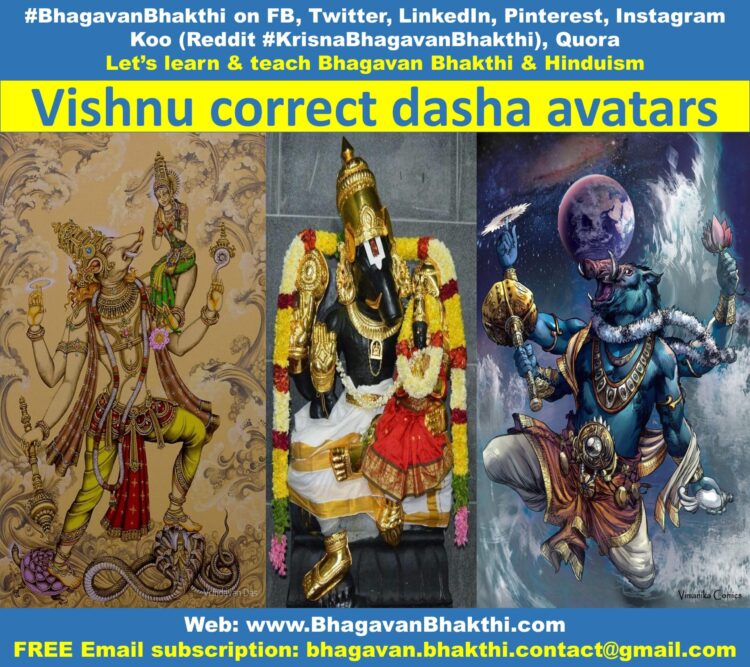
Narasimha avatar or ‘Half-man, Half-lion’ incarnation : Hiranyaksha had a brother named Hiranyakashipu (Hiranyakashyap). Hiranyakshipu was furious to learn that his brother had been killed and he resolved to kill Vishnu.
But this could not be done unless he himself became powerful and invincible.
Hiranyakashipu, therefore, began to pray to Brahma through difficult meditation. Brahma was pleased at these prayers and offered to grant a boon.
“I want to be invincible,” said Hiranyakashipu. “Please grant me the boon that I may not be killed by night or day; that I may not be killed by man or beast; and that I may not be killed in the sky, the water or the earth.”
Brahma granted the desired boon. And Hiranyakashipu was happy. He thought that he had taken care of all possible eventualities.
And since he had become so powerful, he conquered all the three worlds and kicked the gods out of heaven.
Hiranyakashipu had a son named Prahlada. You no doubt remember that Hiranyakashipu had resolved to kill Vishnu.
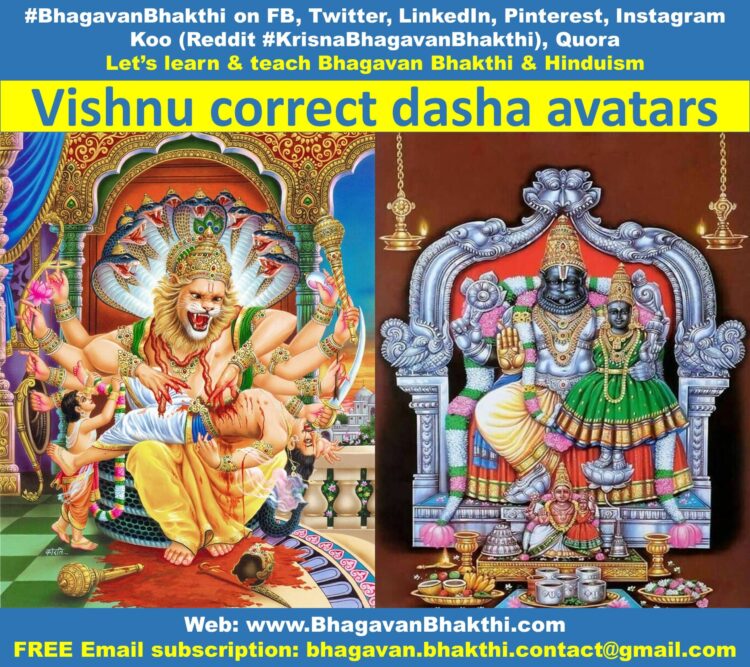
But strangely enough, Prahlada became devoted to Vishnu. Hiranyakashipu tried to persuade his son. That did not work. He tried to kill his son.
That too did not work since, each time, Vishnu intervened to save Prahlada.
Meanwhile, the gods had been driven off from heaven. They had also been deprived of their shares in yajnas by Hiranyakashipu.
These shares now went only to the asura king. In desperation, they went and prayed to Vishnu and Vishnu promised them that he would find a solution.
One day, Hiranyakashipu called Prahlada to him. “How is it that you escaped each time I tried to kill you?,” he asked.
“Because Vishnu saved me,” replied Prahlada. “Vishnu is everywhere.”
“What do you mean everywhere?,” retorted Hiranyakashipu. He pointed to a crystal pillar inside the palace and asked, “Is Vishnu inside this pillar as well?”
“Yes,” replied Prahlada.
“Very well then. I am going to kick the pillar,” said Hiranyakashhipu.
When Hiranyakashipu kicked the pillar, it broke in two . And from inside the pillar, Vishnu emerged in his form of Narasimha, half-man and half-lion.
He caught hold of Hiranyakashipu and placed the demon across his thighs. And with his claws, he tore apart the demon’s chest and so killed him.
Brahma’s boon had been that Hiranyakashipu would not be killed by man or beast, it was half-man and half-beast.
The boon had said that the asura would not be killed in the sky, the water or the earth. But Hiranyakashipu was killed on Vishnu’s thighs, which were not the sky, the water or the earth.
And finally, the boon had promised that Hiranyakashipu would not be killed by night or day. Since the incident took place in the evening, it was not night or day.
After Hiranyakashipu died, the gods were restored to their rightful places. Vishnu made Prahlada the king of the asuras.
Matsya avatar or fish incarnation : Agni told Vashishtha the story of the fish incarnation.
Many years ago, the whole world was destroyed. The destruction in fact extended to all the three lokas (worlds) of bhuloka, bhuvarloka and svarloka.
Bhuloka is the earth, svarloka or svarga is heaven and bhuvarloka is a region between the earth and heaven. All three worlds were flooded with water.
Vaivasvata Manu was the son of the sun-god. He had spent ten thousand years in prayers and tapasya (meditation) in the hermitage vadrika.
This hermitage was on the banks of the river Kritamala.
Once Manu came to the river to perform his ablutions. He immersed his hands in the water to get some water for his ablutions.
When he raised them, he found that there was a small fish swimming in the water in the cup of his hands.
Manu was about to throw the fish back into the water when the fish said, “Don’t throw me back. I am scared of alligators and crocodiles and big fishes. Save me.”
Manu found an earthen pot in which he could keep the fish. But soon the fish became too big for the pot and Manu had to find a larger vessel in which the fish might be kept.
But the fish became too big for this vessel as well and Manu had to transfer the fish to a lake.
But the fish grew and grew and became too large for the lake. So Manu transferred the fish to the ocean. In the ocean, the fish grew until it became gigantic.

By now, Manu’s wonder knew no bounds. He said, “Who are you? You must be the Lord Vishnu, I bow down before you. Tell me, why are you tantalising me in the form of a fish?”
The fish replied, “I have come to punish the evil and protect the good. Seven days from now, the ocean will flood the entire world and all beings will be destroyed.”
“But since you have saved me, I will save you. When the world is flooded, a boat will arrive here. Take the saptarshis (seven sages) with you and spend the terrible night that will come on that boat.”
“Don’t forget to take the seeds of food grains with you. Will arrive and you will then fasten the boat to my horn with a huge snake.” Saying this, the fish disappeared.
Everything happened as the fish had promised it would. The ocean became turbulent and Manu climbed into the boat.
He tied the boat to the huge horn that the fish had. He prayed to the fish and the fish related the Matsya Purana to him.
Eventually, when the water receded, the boat was anchored to the topmost peak of the Himalyas. And living beings were created once again.
A danava (demon) named Hayagriva had stolen the sacred texts of the Vedas and the knowledge of the brahman.
In his form of a fish, Vishnu also killed Hayagriva and recovered the Vedas.
Kurma avatar or turtle incarnation : Many years ago there was a war between the devas (gods) and the daityas (demons) and the gods lost this war.
They prayed to Vishnu to rescue them from the oppression of the demons.
Vishnu told Brahma and the other gods that they should have a temporary truce with the demons.
The two sides should get together to churn the ocean. Vishnu would ensure that the devas benefited more from this churning of the ocean than the daityas did.
The truce was agreed upon and the two sides got ready to churn the ocean.
The mountain Mandara was used as a churning rod and the great snake Vasuki as the rope for churning.

The devas grasped Vasuki’s tail and the daityas grasped Vasuki’s head. But as the churning began, the mountain Mandara which had no base, started to get immersed in the ocean.
What was to be done? Lord Vishnu came to the rescue. He adopted the form of a turtle and the peak was balanced on the turtle’s back.
As the churning continued, terrible poison named kalakuta emerged from the depths of the ocean and was swallowed by Shiva.
Shiva’s throat became blue from this poison and he is therefore known as Nilakantha, blue of throat.
The goddess Varuni, the goddess of wine (sura), came out next. The gods readily accepted her and thus they came to be known as suras.
But the demons rejected Varuni and were therefore known as asuras. She was followed by the parijata tree, a beautiful tree that came to occupy the pride of place in Indra’s garden.
A jewel named koustubha emerged and was accepted by Vishnu as his adornment.
Three wonderful animals came out next – the cow Kapila, the horse Ucchaishrava and the elephant Airavata.
They were followed by apsaras, beautiful women who became dancers of heaven. They were known as apsaras because they emerged from ap (water).
The goddess Lakshmi or Shri came out next and was united with Vishnu.
Finally, Dhanvantari emerged with a pot of amrita (the life-giving drink) in his hands. Dhanvantariwas the originator of medicine (ayurveda).
The daityas led by Jambha gave half of the amrita to the devas and departed with the remaining half.
But Vishnu quickly adopted the form of a beautiful woman. So beautiful was the woman that the demons were charmed. “Pretty lady,” they said, “Take the amrita and serve it to us. Marry us.”
Vishnu accepted the amrita, but he had no intention of giving it to the demons. He served it to the gods instead.
There was only one demon who was somewhat clever. His name was Rahu. He adopted the form of Chandra, the moon-god, and succeeded in drinking some of the amrita.
The sun-god and the moon-god noticed what was happening and reported it to Vishnu. Vishnu thereupon cut off Rahu’s head with a sword.
But Rahu had drunk the amrita, so he could not die. He prayed to Vishnu and Vishnu granted him a boon.
The boon was that occasionally Rahu would be permitted to swallow up the sun and the moon, since these were the gods who had complained about him.
You can see this happening at the time of the solar and the lunar eclipses. People who give alms during such eclipses are blessed.
The gods obtained the amrita and the demons did not. Thus, the gods became more powerful than the demons.
They defeated the demons and regained heaven.
Vamana avatar or The Dwarf incarnation : Prahlada’s grandson was Bali (read as Bali and not as Baali or Vaali) and Bali became very powerful.
When he was the king of the asuras, there was a war between the devas and the asuras. The gods were defeated and were driven off from svarga.
As always, the gods fled to Vishnu and began to pray to him to save them. Vishnu assured the gods that he would do something about Bali.
Accordingly, Vishnu was born as the son of Aditi and Kashyapa. The son was a dwarf.
King Bali had arranged for a huge sacrifice and had announced that, on the occasion of the sacrifice, he would not refuse anyone a boon.
The dwarf arrived at this sacrifice and began to recite the Vedas.
Bali was so pleased at this that he offered the dwarf a boon. Bali’s guru (teacher) was Shukracharya and Shukracharya thought that there was something fishy about the way the dwarf had arrived.
So he tried to restrain Bali.
“No,” said Bali. “I have offered a boon and I shall stick to my word.” What boon do you desire? I will give whatever you want.”
Before a boon was actually granted, a small rite had to be performed with holy water. Shukracharya was still trying to do his best to prevent the boon from being given.
So he entered the vessel in which the holy water was kept to seal the mouth of the vessel and prevent the water from being taken out.
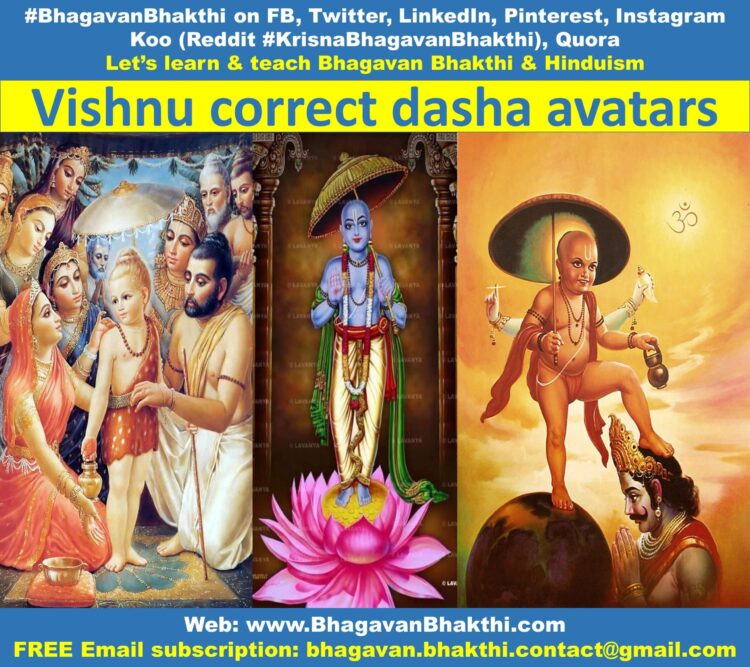
To get at the holy water, the vessel was pierced with a straw. This straw also pierced one of Shukracharya’s eyes.
Ever since that day, the preceptor of the demons has been one-eyed.
“Give me as much of land as may be covered in three of my steps,” said the dwarf. “I need this as dakshina (fee) for my guru.”
Bali agreed. But the dwarf adopted a gigantic form. With one step he covered bhuloka.
With another step he covered bhuvarloka. And with the last step he covered svarloka. The three worlds were thus lost to Bali and Vishnu returned them to Indra.
Bali had no option but to go down to the underworld (patala). But so pleased was Vishnu at Bali’s generosity that he granted the asura the boon that he would bear the title of Indra in the future.
Parashurama avatar : The kshatriyas were the second of the four classes. It was their job to wear arms and protect the world. And rule.
The brahmanas were the first of the four classes. It was their job to pray, study the sacred texts and perform religious rites.
But the kshatriyas became very insolent and began to oppress the world and the brahmanas.
Vishnu was then born as the son of the sage Jamadagni and his wife Renuka.
Since this was the line of the sage Bhrigu, Parashurama was also called Bhargava. Parashurama’s mission was to protect the brahmanas and teach a lesson to the kshatriyas.
There was a king named kartavirya who had received all sorts of boons from the sage Dattatreya.
Thanks to these boons, Kartavirya had a thousand arms and conquered and ruled over the entire world.
One day, Kartavirya went on a hunt to the forest. He was very tired after the hunt and was invited by the sage Jamadagni to rest at the sage’s hermitage. Jamadagni had a kamadhenu cow.
This meant that the cow producted whatever its owner desired. Jamadagni used the kamadhenu to treat Kartavirya and all his soldiers to a sumptuous feast.
Kartavirya was enamoured of the kamadhenu that he asked the sage to give it to him.
But Jamadagni refused. Kartavirya then abducted the cow by force and a war started between Kartavirya and Parashurama.
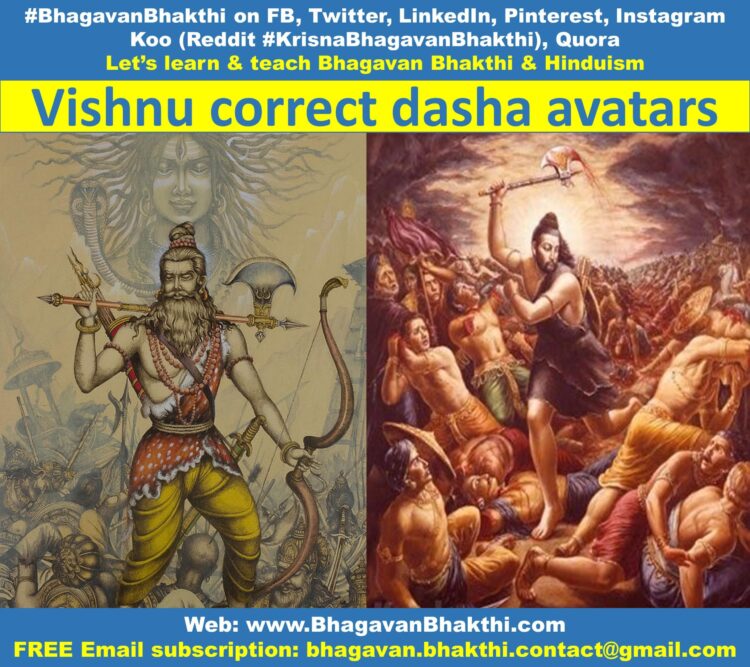
In this war, Parashurama cut off Kartavirya’s head with his axe (parashu) and brought the kamadhenu back to the hermitage.
After some time, Parashurama was away when Kartavirya’s sons arrived at the ashrama and killed Jamadagni.
On the death of his father, Parashurama’s anger was aroused. He killed all the kshatriyas in the world twenty-one times.
On the plains of Kurukshetra, he built five wells which were filled with the blood of kshatriyas.
Eventually, Parashurama handed over the world to Kashyapa and went and lived on Mount Mahendra.
Sri Rama avatar : Brahma came out of Vishnu’s navel. Brahma’s son was Marichi, Marichi’s son Kashyapa, Kashyapa’s son Surya, Surya’s son Vaivasvata Manu.
Similarly, Manu’s son Ikshvaku, Ikshvaku’s son Kakutstha, Kakutstha’s son Raghu, Raghu’ son Aja, Aja’s son Dasharatha, Dasharatha’s sons were Rama, Bharata, Lakshmana and Shatrughna.
Since Rama was descended from Kakutstha and Raghu, he was also called Kakutstha and Raghava.
Since his father’s name was Dasharatha, he was also called Dasharathi. Rama’s story belongs to the solar line (surya vamsha), since one of his ancestors was Surya.
Vishnu himself wished to destroy Ravana and the other rakshasas (demons). He therefore divided himself into four parts and was born as Rama, Bharata, Lakshmana and Shatrughna.
Rama was Koushalya’s son, Bharata Kaikeyi’s. Lakshmana and Shatrughna were the sons of Sumitra.
The sage Vishvamitra came to Dasharatha and pleaded for Rama’s help in defeating the rakshasas who were disturbing his yajnas.
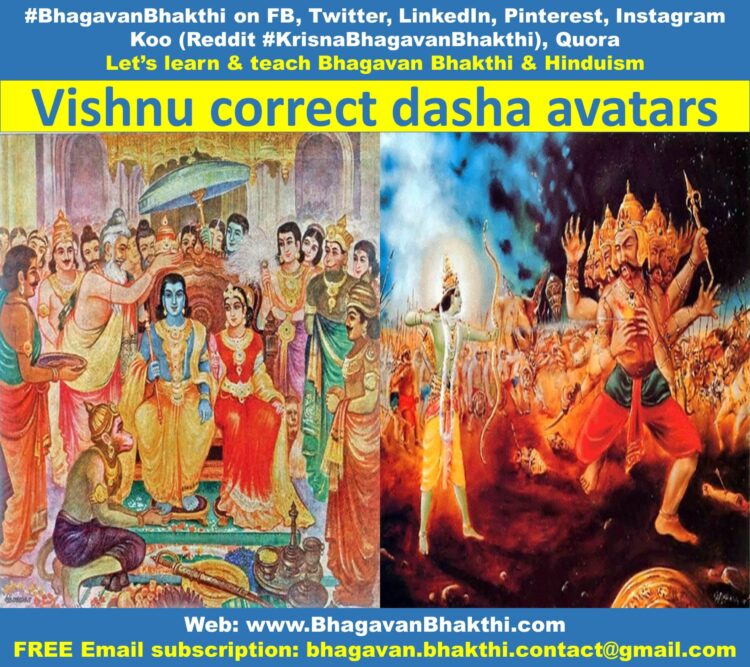
Rama killed these demons and Vishvamitra was so pleased that he taught Rama the use of all divine weapons.
Rama broke a bow of Shiva’s that had been in the possession of the king of Mithila, Janka. This was the task that had been appointed for marrying Sita, Janaka’s daughter.
Rama married Sita, Lakshmana married Urmila, Bharata married Mandavi and Shatrughna married Shrutakirti. On the way back to Ayodhya, Rama also beat Parashurama in a duel.
Dasharatha resolved that Rama should be made yuvaraja, that is, the heir apparent to the kingdom.
But Kaikeyi had a servant named Manthara who plotted otherwise. When he was young, Rama had pulled at Manthara’s feet and ever since that day.
Manthara had not been kindly disposed towards Rama. She reminded Kaikeyi of the two boons that had been promised to her by King Dasharatha.
Years ago, the gods had been fighting with the demon Shambara and had asked Dasharatha for his help. In fighting with Shambara, Dasharatha had been injured. He had been nursed back to health by Kaikeyi.
Dasharatha had promised two boons to Kaikeyi as a reward and Manthara’s suggestion was that Kaikeyi should now ask for these two boons.
By the first boon Rama would be banished to the forest for fourteen years and by the second boon Bharata would become yuvaraja.
Kaikeyi listened to Manthara. At Manthara’s instance, she asked for these two boons.
Dasharatha was very angry, but Rama insisted that he would indeed go to the forest for fourteen years.
Rama, Lakshmana and Sita first went to the banks of the river Tamasa.
From there they went to the kingdom of Guha, the king of the hunters (nishadas). They crossed the river Jahnavi and arrived in Prayaga, where the sage Bharadvaja had his hermitage.
Their final destination was the mountan range of Chitrakuta, on the banks of the river Mandakini. Meanwhile, back home in Ayodhya, King Dasharatha who could not bear to be parted from Rama, died.
Bharata and Shatrughna had gone on a visit to their uncle’s house and were recalled.
But Bharata refused to be king. He went to the forest to try and persuade Rama to return, but Rama insisted that he would not return before the fourteen years were over.
So Bharata brought back Rama’s sandals. He placed these sandals on the throne as a token of Rama’s kingship.
And he began to rule the kingdom in Rama’s name from Nandigrama, rather than from Ayodhya. Rama, Lakshmana and Sita then went to the forest that is known as the Dandaka forest, dandakaranya.
This forest was on the banks of the river Godavari and there was a beautiful grove inside the forest known as Panchavati.
They built a hut there and resolved to live there.
There was a rakshasa woman named Shurpanakha. She happened to come to the place where Rama, Lakshmana and Sita had built their hut.
Shurpanakha liked Rama so much that she wanted to marry Rama and eat up Lakshmana and Sita. But Lakshmana cut off Shurpaakha’s nose and ears with his sword.
Shurpanakha fled to her brother Khara and demanded revenge. Khara and fourteen thousand other demons (rakshasas) attacked Rama, but they were all killed by Rama.
Shurpanakha then went to her other brother Ravana, the king of Lanka. Ravana asked the rakshasa Maricha to adopt the form of a golden deer and roam around in front of Rama’s hut.
Sita was so charmed by the deer that she asked Rama to capture it for her.
Rama was long in returning and Lakshmana went to look for him. Taking advantage of Rama and Lakshmana’s absence. Ravana kidnapped Sita.
Jatayu, the king of the birds, did try to stop Ravana, but he met his death at Ravana’s hands. Rama and Lakshmana were greatly distressed to find Sita missing and they looked for her everywhere.
Rama made friends with the monkey Sugriva. He killed Sugriva’s brother Bali and made Sugriva the king of the monkeys.
The monkeys were sent off in all the four directions to look for Sita. The monkeys who had gone towards the south learnt that Sita was in Lanka, across the ocean.
One of these monkeys was Hanuman. Hanuman leapt over the ocean and arrived in Lanka. He discovered the lonesome Sita in a grove of ashoka trees, the ashokavana.
Hanumana introduced himself and assured Sita that he would soon be back with Rama. Hanuman caused some general havoc in Lanka and was captured by Meghnada or Indrajit, Ravana’s son.
Ravana ordered that Hanumana’s tail should be set on fire. But Hanuman used his burning tail to set fire to all the houses of Lanka.
He then returned to Rama with the news that Sita had been found. Rama, Lakshmana and the army of monkeys arrived at the shores of the ocean.
There they built a bridge over the ocean so that they could cross over into Lanka. There was a terrible war in which Rama killed the giant Kumbhakarna, Ravana’s brother.
Lakshmana killed Indrajit. Rama killed Ravana with a powerful divine weapon, the brahamastra. The fourteen years were by now over and Rama, Lakshmana and Sita returned to Ayodhya.
There Rama was crowned king and he treated his subjects as his own sons. He punished the wicked and followed the path of dharma.
During Rama’s rule there was no shortage of food grains anywhere and the people were righteous. No one died an untimely death.
On Rama’s instructions, Shatrughna killed the asura Lavana and built the city of Mathura in the place where Lavana’s kingdom had been.
Bharata was sent by Rama to kill a wicked gandharva a singer of heaven named Shailusha, who lived on the banks of the river Indus with his sons.
Bharata killed them and built two cities there, Takshashila and Pushkaravati.
In Takshashila Bharata established his son Taksha as king and in Pushkaravti he made his son Pushkara the king. Rama and Sita had two sons named Kusha and Lava.
Rama ruled for eleven thousand years before he went to Vaikuntha. This is the story of the Ramayana as recounted in the Agni Purana.
It was written by the sage Valmiki after he had heard the story from the sage Narada. Rama was the seventh avatar of Vishnu. Krishna was the eighth.
Sri Krishna avatar (and the lineage of Sri Krishna) : As you have already been told, Brahma emerged from Vishnu’s navel. Brahma’ son was Atri, Atri’s son Soma, Soma’s son Pururava, Pururava’s son Ayu, Ayu’s son Nahusha and Nahusha’s son Yayati.
Yayati had two wives, Devayani and Sharmishtha.
Devayani had two sons, Yadu and Turvusu. And Sharmishtha had three sons, Druhya, Anu and Puru. The descendants of Yadu were known as the Yadavas.
Vasudeva was a Yadava. His wife was Devaki. Vishnu was born as the son of Vasudeva and Devaki in order to remove the wicked from the world.
The seventh son of Vasudeva and Devaki was Baladeva. And the eighth son was Krishna himself. Krishna was born in the month of Bhadra in the thick of the night.
Scared that the wicked Kamsa might kill the newly child, Vasudeva left him with Yashoda, the wife of Nanda.
Nanda was the king of the cowherds and he brought up Baladeva and Krishna. Kamsa sent a rakshasa woman named Putana to kill Krishna, but Krishna killed her instead. In Vrindavana, Krishna subdued the terrible snake known as Kaliya.
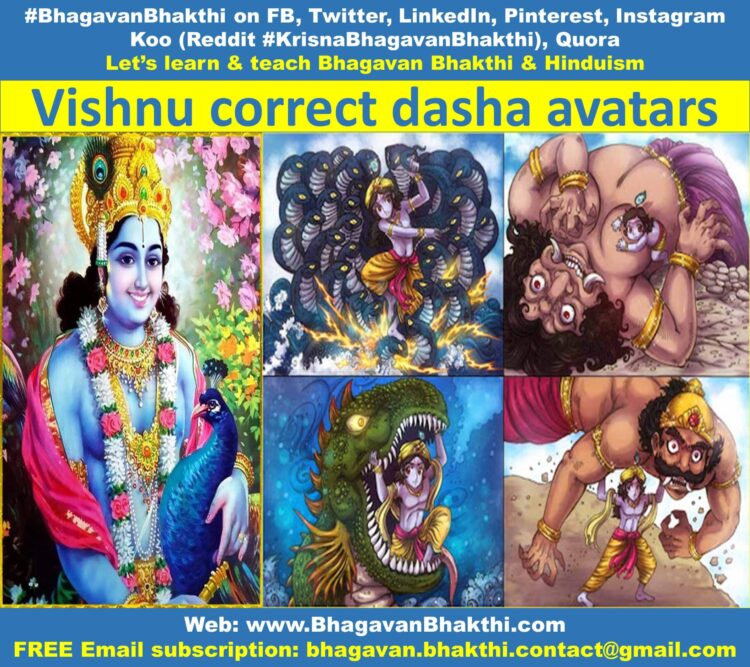
He killed several other rakshasas named Arishta, Vrishabha, Keshi, Dhenuka and Gardhabha and made the country safe from the attacks of these demons. He also stopped the worship of Indra.
This led to a fight between Indra and Krishna , Indra tried to destroy the inhabitants of Gokula by sending down torrents of rain.
But Krishna held aloft the mountain Govardhana and saved the inhabitants of Gokula.
Kamsa’s capital was in Mathura, Baladeva and Krishna went there. Kamsa let loose a mad elephant named Kuvalayapida on Krishna. But Krishna killed Kuvalayapida.
Baladeva and Krishna also killed two strong wrestlers, Chanura and Mushtika, whom Kamsa had instructed to kill Baladeva and Krishna.
Finally, Krishna killed Kamsa and made Ugrasena the king. Kamsa was Jarasandha’s son- in-law and Jaradsandha became furious when he learnt of Kamsa’s death.
He attacked the Yadavas and laid siege to the city of Mathura. After a prolonged war, Krishna managed to defeat Jarasandha. Krishna also defeated another evil king named Poundraka.
On Krishna’s instructions, the Yadavas built the beautiful city of Dvaraka or Dvarakati. The Yadavas began to live in Dvaraka.
There was an asura named Naraka who was killed by Krishna. Naraka had imprisoned sixteen thousand daughters of the devas, gandharvas and yakshas (guards of heaven’s treasury).
These women were freed by Krishna and Krishna married all of them. Among Krishna’s other exploits were defeating the daitya Panchajana, killing Kalayavana, seizing the parijata tree from Indra and bringing back to life the sage Sandipani’s dead son.
Krishna had several sons. Shamba was born of Krishna’s wife Jambavati and Pradyumna was born of Krishna’s wife Rukmini.
As soon as Pradyumna was born, he was abductd by the asura Shambara. Shambara threw the baby into the sea, but a fish swallowed the baby.
A fisherman caught the fish and brought it to Shambara’s house. When the fish’s stomach was cut open, the baby came out.
There was a woman named Mayavati who lived in Shambara’s house and Shambara handed over baby Pradyumna to Mayavati so that he might be brought up well.
When he grew up, Pradyumna killed Shambara and married Mayavati. They returned to Dvaraka and Krishna was happy to see his lost son.
Pradyumna and Mayavati had a son named Aniruddha. Aniruddha secretly married Usha, the daughter of King Vana, Vana himself being the son of Vali.
Vana’s capital was in a city named Shonitapura. Vana had pleased Shiva through hard and difficult tapasya, so that sometimes he was called the son of Shiva.
Vana loved to fight and he had wanted a boon from Shiva that he might get the chance to fight with someone who was his equal in battle.
A flag with a peacock on it used to fly from the ramparts of Vana’s palace. Shiva told him that the day this flag fell down, Vana’s desire for battle with an equal would be satisfied.
With the help of a friend of Usha’s, Aniruddha and Usha used to meet secretly in Vana’s palace. Vana’s guards informed him about this and there was a fierce battle betweeen Vana and Aniruddha.
At the same time, the flag with the peacock on it fell down. Krishna got to know from Narada about the fight between Vana and Aniruddha and he, Baladeva and Pradyumna arrived in Vana’s capital.
Shiva came to fight on Vana’s side, accompanied by Nandi and Skanda or Kartikeya. But after a duel that lasted for a long time, Krishna triumphed over these enemies.
Krishna’s arrows also cut off the thousand arms that Vana had. But at Shiva’s request, Krishna spared Vana’s life and gave him two arms with which to make do.
All of these stories about Krishna are related in detail in the Harivamsha. The Agni Purana merely gives a brief summary of the Harivamsha.
But stories about Krishna, the eighth avatar of Vishnu, also crop up in the Mahabharata. The Agni Purana, therefore, next summarizes the Mahabharata.
The Mahabharata : The Pandavas were merely a pretext. Krishna used the Pandavas to rid the world of evil men.
You have already learnt that one of Yayati’s sons was Puru. In Puru’s line were born Bharata and Kuru.
One of Kuru’s descendants was the king Shantanu. Shantanu married Ganga and Bhishma was born from this marriage.
But Shantanu also married Satyavati and had two more sons, Chitrangada and Vichitravirya. Bhishma never married. Chitrangada died young.
When Vicitravirya grew up, Bhishma defeated the king of Kashi and brought two of the king’s daughters, Ambika and ambalika, as brides for Vichitravirya.
Vichitravirya was also quite young when he died of tuberculosis. Since Vichitravirya had left no children, Vyasadeva was brought to Hastinapura.
Vyasadeva and Ambika had a son named Dhritarashtra and Vyasadeva and Ambalika had a son named Pandu.
Dhritarashtra married Gandhari and they had a hundred sons, of whom the most important was Duryodhana. Pandu had two wives, Kunti and Madri.
Kunti’s sons were Yudhishthira, Bhima and Arjuna and Madri’s son were Nakula and Sahadeva. But Yudhisthira was really the son of the god Dharma and not Pandu’s son.
Similarly, Bhima was the son of the god Pavana. Arjuna the son of Indra and Nakula and Sahadeva the sons of the two Ashvinis.
Earlier, Kunti had had a son named Karna from the sun-god. This was before she had got married to Pandu. Karna became a friend of Duryodhana’s.
Because of a curse imposed on him by a sage, Pandu died in the forest. Duryodhana tried his best to kill the Pandavas. He set fire to a house of lac (jatugriha) in which Kunti and the five Pandavas were staying.
But the Pandavas were saved and fled to a city named Ekachakra. There they lived, disguised as brahmanas. In Ekachakra, they destroyed a rakshasa named Vaka.
They then won the hand of the daughter of the king of Panchala. Her name was Droupadi and all five Pandava brothers married her.
When Duryodhana learnt that the Pandavas were alive, he handed over half the kingdom to them. Meanwhile, the forest Khandava had to be burnt and Krishna and Arjuna did this together. Krishna had befriended Arjuna.
When Arjuna successfully defeated the god Agni at the burning of the Khandava forest, Agni gave him several divine weapons.
Arjuna had also obtained divine weapons from his guru Dronacharya. On the Pandava side, Yudhishthira had become king.
The Pandavas organised a rajasuya yajna (royal sacrifice) in which they conquered several kingdoms and accumulated a lot of wealth.
This made Duryodhana envious. He arranged a game of dice (aksha) between Yudhishthira and Duryodhana’s uncle Shakuni.
Shakuni did not play fairly and Yudhisthira lost the game. As a penalty for the loss, the Pandavas were to spend twelve years in the forest and one additional year without being detected.
Draupadi went with them to the forest, as did the Pandava’s priest, Dhoumya.
After the twelve years were over, the Pandavas came to the kingdom of King Virata where they proposed to spend the additional year that had to be spent in disguise.
Yudhishthira pretended to be a brahmana, Bhima cook, Arjuna dancer, Nakula and Sahadeva stable-hands.
Draupadi became the queen’s maid. The queen’s brother Kichaka tried to molest Draupadi, but was killed by Bhima.
When the year was over, the Kauravas attacked King Virata to rob him of his cattle.
But Arjuna defeated all the Kauravas and saved Virata’s cattle. After this success, the identity of the Pandavas could no longer be kept a secret.
But thankfully, the one year during which identities had to be kept a secret, was over.
King Virata’s daughter Uttara was married to Abhimanyu, Arjuna’s son. Abhimanyu’s mother was Subhadra, whom Arjuna had married. Subhadra also happened to be Krishna’s sister.
The Pandavas now demanded their rightful share of the kingdom, but Duryodhana refused. A war was imminent.
A huge battalion of soldiers was known as an akshouhini. Duryodhana collected eleven akshouhinis for the war and Yudhishthira collected seven.
Krishna was sent as a messenger to Duryodhana to try and preserve the peace, Krishna told Duryodhana that the Pandavas would be satisfied with a mere five villages.
Duryodhana refused to give them even this without a fight. So the armies gathered for a war on the plains of Kurukshetra. Noticing that elders and relatives like Bhishma and Dronacharyas were fighting on the side of the Kauravas.
Arjuna was reluctant to fight. But Krishna gave Arjuna lessons which have come down to us as the Gita.
He taught that there was no reason for sorrow if Bhishma or Dronacharya died. That true identity of a person was his atman (soul) which never died, but passed from one body to another.
True bliss was obtained when the atman united with the brahman( divine essence) or paramatman (supreme soul).
This was always the goal of a yogi, that is a person who sought union with god. Thus instructed by Krishna, Arjuna started to fight. With the help of Shikhandi, he defeated Bhishma.
This happened on the tenth day of the fighting. Bhishma did not however die. He had earlier received the boon that he would only die when he actually wished to do so.
For many days, he lay there in the battlefield on a bed of arrows. After Bhishma’s defeat, Dronacharya became the general of the Kauravas.
Dhrishtadyumna was the general on the Pandava side. Dronacharya killed Virata, Drupada and several other kings and soldiers on the Pandava side.
Dhrishtadyumna also killed many Kaurava soldiers. On the fifteenth day of the fighting, a rumour gained currency that Ashvatthama, Dronacharaya’s son, had been killed.
Dronacharya abandoned his weapons on hearing this bad news and Dhrishtadyumna faced not problems in killing him.
Karna now became the Kaurava general and lasted for two and a half days before he was killed by Arjuna. Shalya was the last Kaurava general.
He fought for only half a day and was killed by Yudhishthira. Bhima and Duryodhana fought the last duel of the war with maces. Bhima broke Duryodhana’s thighs and killed him.
Ashvatthama had been fuming ever since his father Dronacharya had been killed by unfair means.
In the dead of the night, he entered the Pandava camp where he killed Dhristadyumna and the five sons of Droupadi. Droupadi was disconsolate and demanded revenge.
Arjuna and Ashvatthama let loose divine weapons at each other. Since this might destroy the world, they were asked to withdraw these weapon.
Arjuna could withdraw his weapon, but Ashvatthama could not. Ashvatthama’s weapon killed the baby that was in Uttara’s womb, but when the dead baby was born, Krishna brought it back to life. This baby was Parikshita.
Many kings and soldiers died in the course of the Kurukshetra war.
The only ones left alive were Kritavarma, Kripacharya and Ashvatthama on the Kaurava side and Satyaki, Krishna and the five Pandavas on the Pandava side.
After the war was over, Bhishma taught Yudhishthira the duties of a king. It was only after this that he died.
As a king, Yudhishthira performed many yajnas and gave a lot of alms to brahmanas. When Yudhishthira learnt that the Yadavas had been destroyed, he no longer wished to rule.
He handed over the kingdom to Parikshita and the Pandavas left on a pilgrimage, in the course of which they died.
It was Krishna who had used the Pandavas as a tool to rid the world of evil kings and establish the good ones.
Realizing that the Yadavas were also evil, Krishna also ensured that the Yadavas would be destroyed.
He then gave up his life at the place of pilgrimage that is known as Prabhasa. After Krishna died, the city of Dvaraka was swallowed up by the sea. This was the story of the eighth avatar of Vishnu.
Buddha Avatar and Kalki Avatar : The ninth avatar of Vishnu was Buddha and the tenth will be Kalki.
Many years ago, there was a war between the devas and the asuras in which the demons managed to defeat the gods.
The gods went running to Vishnu for protection and Vishnu told them that Mayamoha would be born as Buddha, the son of Shuddhodana.

Such were the illusions that Buddha created, that the asuras left the path indicated by the Vedas and became Buddhists.
These dastardly creatures performed ceremonies that were a sure ticket to Naraka. Towards the end of the Kali era, all people will be dastardly.
They will oppose the Vedas, become robbers and will be concerned only with wealth. The disbelievers will then become kings and these kings will also be cannibals.
Much later, Kalki will be born on earth as the son of Vishnuyasha. He will take up arms to destroy these disbelievers.
Kalki’s priest will be the sage Yajnavalkya. The norms of the four classes (varna) and the four stages of life (ashrama) will be established yet again.
People will honour the sacred texts and become righteous. It will then be time for the dawn of a new satya yuga, a fresh period of righteousness.
In every cycle (kalpa) and in every era (manvantara) Vishnu is thus born in various forms. It is sacred duty to listen to the stories of then ten avatars. The listener attains his desires and goes to heaven.
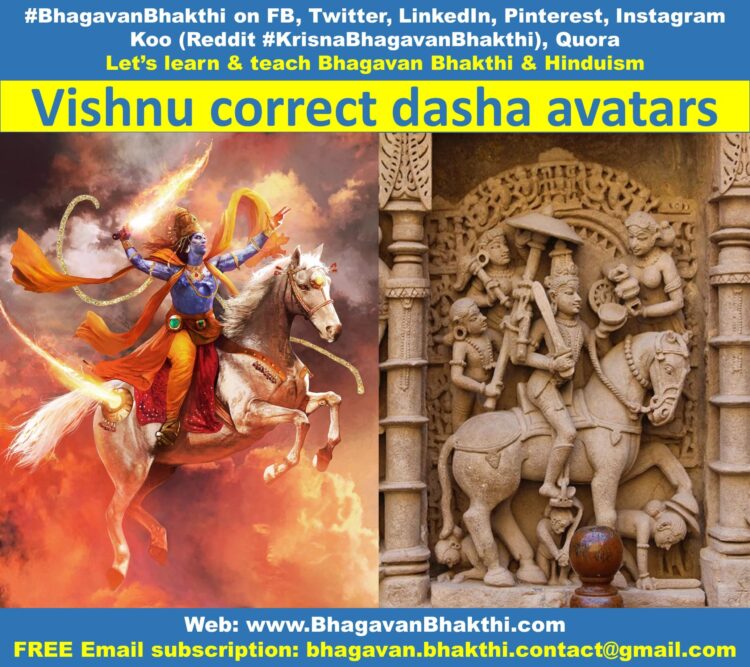
More information will be added to this on regular basis, please visit after some time to know more information.
To know about “Rivers in India (Hinduism) information“, please check the below link:
Rivers in India (Hinduism) information
To watch videos on #Hinduism #Sanskrit language, SUBSCRIBE to my YouTube channel from this below link:
#BhagavanBhakthi YouTube channel
Continue reading to know about “Mahabharata information, facts, significance, importance” from here:
Mahabharata information, facts, significance, importance
Continue reading to know about “Lord Sri Vishnu information (facts) (details)” from here:
Lord Sri Vishnu information (facts) (details)
To watch about “Lord Sri Krishna information” YouTube video, click the below YouTube video link:
Lord Sri Krishna information (YouTube videos)
To read about “Lord Sri Krishna information (website / blog reading)“, please click the below link:
Lord Sri Krishna information (website / blog reading)
Dear friends, if you need any clarifications about this post, kindly let me know, I will definitely try to answer all of them.
Also your one LIKE, one COMMENT, One Share, one SUBSCRIPTION is highly important.
This will help to know the quality of this content and also it will be helpful to know if any improvements is required for the content.
If you feel this content is useful to you and has helped you to improve your knowledge, kindly share this with your well-wishers.
Because “SHARING MEANS CARING”.
To receive FREE EMAIL SUBSCRIPTION about #BhagavanBhakthi, you can send an email to [email protected] from your email ID.
NAMASTE!
Sri Gurubhyo Namaha
Sri Krishnaaya Namaha
Sri Krishnaarpanamastu
Share in Social Media
you just gave the detail information or an explanation about DASHAVATARS. but where are the proofs? can you please post the proofs that shows us DASHAVATARS really took place?
Dear Bharathi Ji,
Thanks for your comment.
This is as per Srimad Bhagavatam. You need to read this great and divine text to know the proof.
Shubhamastu!